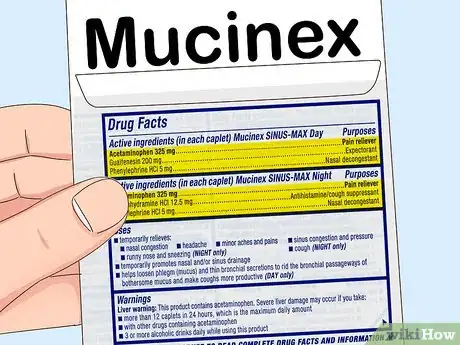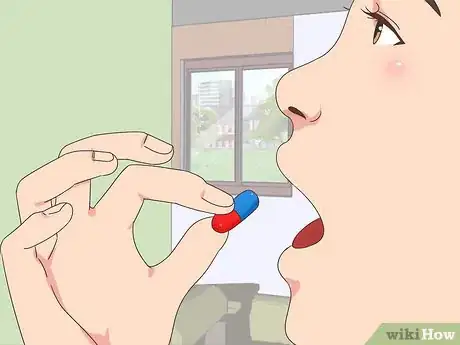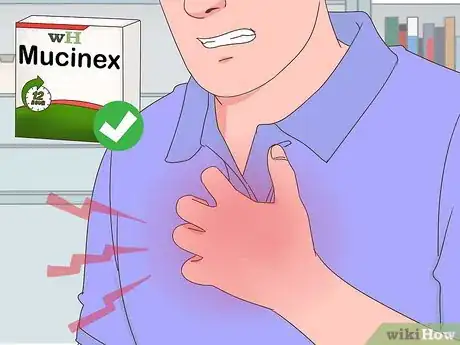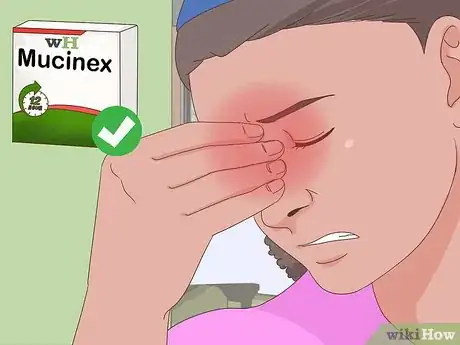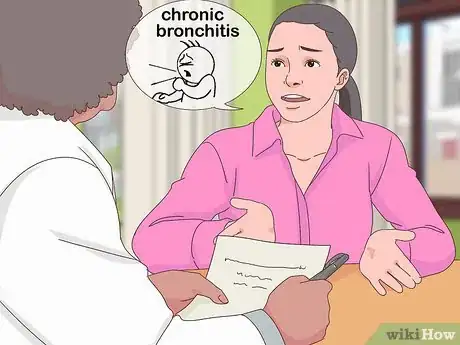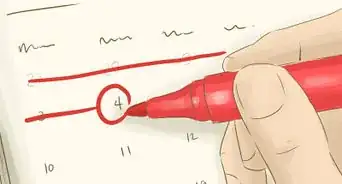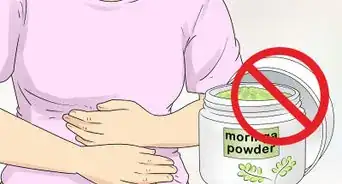This article was co-authored by Luba Lee, FNP-BC, MS and by wikiHow staff writer, Megaera Lorenz, PhD. Luba Lee, FNP-BC is a Board-Certified Family Nurse Practitioner (FNP) and educator in Tennessee with over a decade of clinical experience. Luba has certifications in Pediatric Advanced Life Support (PALS), Emergency Medicine, Advanced Cardiac Life Support (ACLS), Team Building, and Critical Care Nursing. She received her Master of Science in Nursing (MSN) from the University of Tennessee in 2006.
There are 12 references cited in this article, which can be found at the bottom of the page.
This article has been viewed 32,447 times.
Mucinex is a brand name for guaifenesin, an over-the-counter medication that thins mucus and provides relief for chest or sinus congestion. Other common brand names for guaifenesin include Robitussin, Antitussin, and Allfen in the US, or Balminil Expectorant, Benylin-E, and Resyl in Canada. Take Mucinex correctly to get safe, effective relief from chest or sinus congestion. Before you start taking Mucinex, assess whether it is the right medication for your symptoms.
Steps
Using Mucinex Correctly
-
1Follow the dosage directions on the package. Mucinex comes in several concentrations and formulations. Read the package directions carefully to make sure you know how much Mucinex to take, and how often. The correct dosage may also vary depending on your symptoms, your age, and other considerations.[1]
- If you're not sure how much Mucinex to take, talk to your doctor. Do not take more than the recommended amount of Mucinex unless your doctor directs you to do so.
- Most short-acting doses should be taken once every 4 hours. Extended-release or long-acting doses should be taken once every 12 hours.
- Adults and children over 12 can take 1 or 2 tablets that are 600 mg every 12 hours. Do not take more than 4 tablets within 24 hours.
-
2Take Mucinex with lots of water. Keeping yourself hydrated can make Mucinex more effective. Take each dose of Mucinex with a full glass of water. Drinking warm, clear liquids, such as broth, tea, or warm apple juice, can also help loosen your mucus and relieve congestion.[2]Advertisement
-
3Swallow Mucinex tablets or capsules whole. Crushing, chewing, or breaking open tablets can make them less effective. Crushing or chewing an extended-release medication can release the medicine into your system too quickly, potentially causing harmful effects.[3] Always swallow Mucinex tablets or capsules whole, unless your doctor directs you otherwise.
- If you have trouble swallowing pills, take Mucinex in liquid form.
-
4Avoid driving or using machinery while taking Mucinex. Mucinex is a relatively safe medication, but it can cause drowsiness. For this reason, you should not operate heavy machinery, drive for long periods, or drink alcohol while taking Mucinex.[4]
- Mucinex may also make you feel spacey or unable to concentrate. You may not want to perform tasks that require heavy concentration while you are taking it.
-
5Ask your doctor about taking Mucinex with other medications. There are no known drug interactions for guaifenesin, the primary active ingredient in Mucinex. However, some Mucinex formulations contain other ingredients, such as acetaminophen or dextromethorphan. These ingredients may interact poorly with other medicines. Always talk to your doctor or pharmacist about any other medications or supplements you are taking before you take Mucinex.[5]
-
6Talk to your doctor if your symptoms get worse or last more than 7 days. Symptoms that get worse, come back, or persist after 7 days might be signs of a serious condition. Stop taking Mucinex and talk to your doctor if you develop a cough that is accompanied by a fever, a rash, or a headache that won't go away.[6]
- If you start coughing up thick or yellow phlegm, you may have an infection. See your doctor to get a prescription medication.
-
7Consult your doctor if you experience side effects with Mucinex. Mucinex side effects are usually mild, and often clear up on their own. Talk to your doctor if you have side effects that are causing you a lot of distress or do not go away after a few doses. Mucinex may cause the following side effects in some people:[7]
- Diarrhea, nausea, or vomiting
- Stomach pain
- Dizziness
- Light headed feeling
- A "spacey" sensation or inability to concentrate
- Headache
- Hives or skin rash
Knowing When to Take Mucinex
-
1Take Mucinex for chest congestion. Mucinex is primarily intended to treat chest congestion associated with common upper respiratory infections, like the cold or flu. Mucinex is an expectorant, meaning that it works by thinning out the mucus and making it easier to cough up.[8]
- There is conflicting evidence about how effective expectorants like Mucinex are for treating coughs.
- Some Mucinex products, such as Maximum Strength Mucinex, also contain a cough suppressant called dextromethorphan. This ingredient works by suppressing your brain's cough reflex. Avoid taking dextromethorphan if you have a chronic cough or are coughing up large amounts of mucus.[9]
- If you are having trouble breathing, coughing up blood, or experiencing pain or pressure in your chest, call your doctor right away.[10]
-
2Use Mucinex to treat nasal or sinus congestion. Mucinex can relieve sinus pressure and make it easier to blow your nose by thinning the mucus in your sinuses and nasal passages. Mucinex may help bring relief from chronic sinusitis, but you should still see your doctor to make sure that you don't have an infection.[11]
- Mucinex makes several medications designed specifically for treating nasal and sinus symptoms. Some of these may contain additional ingredients aside from guaifenesin. For example, Mucinex Sinus-Max also contains acetaminophen (to treat pain) and phenylephrine (a decongestant). For this reason, you should not take Tylenol (which is also acetaminophen) at the same time as you take Mucinex.
-
3Talk to your pediatrician before giving Mucinex to a child. Children's Mucinex is formulated to treat chest congestion in children ages 4 and up. That said, always consult a doctor before giving young children medication, even children over the age of 4. Giving Mucinex or other cough and cold medications to children younger than 4 may cause dangerous side effects. Talk to your doctor about the best way to treat congestion in babies and children under 4.[12]
- Do not give Mucinex formulated for adults to a child under 12 years of age.
-
4Ask your doctor about Mucinex if you are pregnant or breastfeeding. Mucinex is classified as a Pregnancy Category C medication by the FDA. This means that there is not much information available on how Mucinex might affect a developing fetus, but there may be some risk of adverse effects. Talk to your doctor about the potential risks to your fetus or infant before taking Mucinex while you are pregnant or breastfeeding.[13]
- If you are in the first 3 months of breastfeeding, it is especially important to consult your doctor. If you take Mucinex while breastfeeding, your baby may become lethargic or less active.
-
5Consult with your doctor if your symptoms are chronic or severe. Mucinex may help relieve congestion associated with some chronic conditions. However, it is important to talk to your doctor about the risks and benefits of taking Mucinex for a severe or chronic condition. Ask your doctor about taking Mucinex if you have:[14]
- A chronic cough associated with asthma, chronic bronchitis, or emphysema.
- A cough with excessive mucus or phlegm.
Expert Q&A
-
QuestionHow many ounces is a full glass of water?
 Luba Lee, FNP-BC, MSLuba Lee, FNP-BC is a Board-Certified Family Nurse Practitioner (FNP) and educator in Tennessee with over a decade of clinical experience. Luba has certifications in Pediatric Advanced Life Support (PALS), Emergency Medicine, Advanced Cardiac Life Support (ACLS), Team Building, and Critical Care Nursing. She received her Master of Science in Nursing (MSN) from the University of Tennessee in 2006.
Luba Lee, FNP-BC, MSLuba Lee, FNP-BC is a Board-Certified Family Nurse Practitioner (FNP) and educator in Tennessee with over a decade of clinical experience. Luba has certifications in Pediatric Advanced Life Support (PALS), Emergency Medicine, Advanced Cardiac Life Support (ACLS), Team Building, and Critical Care Nursing. She received her Master of Science in Nursing (MSN) from the University of Tennessee in 2006.
Board-Certified Family Nurse Practitioner You should take Mucines with a full glass of water, which equals 8 ounces or 240 milliliters. It's also the same as 1 cup.
You should take Mucines with a full glass of water, which equals 8 ounces or 240 milliliters. It's also the same as 1 cup. -
QuestionIs it okay to take 2 600-mg tablets in place of 1 1200-mg tablet of Mucinex?
 Luba Lee, FNP-BC, MSLuba Lee, FNP-BC is a Board-Certified Family Nurse Practitioner (FNP) and educator in Tennessee with over a decade of clinical experience. Luba has certifications in Pediatric Advanced Life Support (PALS), Emergency Medicine, Advanced Cardiac Life Support (ACLS), Team Building, and Critical Care Nursing. She received her Master of Science in Nursing (MSN) from the University of Tennessee in 2006.
Luba Lee, FNP-BC, MSLuba Lee, FNP-BC is a Board-Certified Family Nurse Practitioner (FNP) and educator in Tennessee with over a decade of clinical experience. Luba has certifications in Pediatric Advanced Life Support (PALS), Emergency Medicine, Advanced Cardiac Life Support (ACLS), Team Building, and Critical Care Nursing. She received her Master of Science in Nursing (MSN) from the University of Tennessee in 2006.
Board-Certified Family Nurse Practitioner Yes, taking two 600mg tablets of Mucinex is the same as taking one 1200mg tablet of Mucinex.
Yes, taking two 600mg tablets of Mucinex is the same as taking one 1200mg tablet of Mucinex.
References
- ↑ https://www.accessdata.fda.gov/drugsatfda_docs/label/2004/21620_mucinex_lbl.pdf
- ↑ https://www.drugs.com/pro/mucinex.html#s-34068-7
- ↑ https://www.nhs.uk/chq/Pages/2457.aspx?CategoryID=73
- ↑ https://www.drugs.com/mucinex.html
- ↑ https://medlineplus.gov/druginfo/meds/a682494.html#precautions
- ↑ https://dailymed.nlm.nih.gov/dailymed/drugInfo.cfm?setid=d5f046c0-66b9-4cdc-9a1e-8e2cb5ece84f
- ↑ https://dailymed.nlm.nih.gov/dailymed/drugInfo.cfm?setid=d5f046c0-66b9-4cdc-9a1e-8e2cb5ece84f
- ↑ https://www.health.harvard.edu/newsletter_article/no-coughing-matter
- ↑ https://www.deadiversion.usdoj.gov/drug_chem_info/dextro_m.pdf
- ↑ https://my.clevelandclinic.org/health/articles/the-common-cold-and-viral-upper-respiratory-illness
- ↑ https://www.health.harvard.edu/diseases-and-conditions/what_to_do_about_sinusitis
- ↑ https://medlineplus.gov/druginfo/meds/a682494.html#precautions
- ↑ https://www.aafp.org/afp/2014/1015/p548.html
- ↑ https://www.medsafe.govt.nz/Consumers/cmi/CoughandCold/Guaifenesin1.pdf
